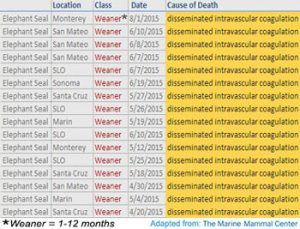
Baby seals are dying of a leukemia related disorder along the California coast
ENE News reports: Of the 46 recently weaned northern elephant seals deaths reported by the San Francisco Bay Area’s Marine Mammal Center between April 20 and August 1 of this year, Disseminated Intravascular Coagulation was listed as a cause of death in 16 — over 1/3 of the total. 
U.S. National Library of Medicine (emphasis added): Disseminated intravascular coagulation (DIC) is a serious disorder in which the proteins that control blood clotting become over active… Risk factors for DIC include: Blood transfusion reaction; Cancer, especially certain types of leukemia…

BYPASS THE CENSORS
Sign up to get unfiltered news delivered straight to your inbox.
You can unsubscribe any time. By subscribing you agree to our Terms of Use
Video by BPEarthwatch
DIC “is a pathological process characterized by the widespread activation of the clotting cascade that results in the formation of blood clots in the small blood vessels throughout the body… and can ultimately lead to multiple organ damage… severe bleeding can occur from various sites. DIC does not occur by itself but only as a complicating factor from another underlying condition, usually in those with a critical illness… DIC can lead to multiorgan failure and widespread bleeding… Causes — DIC can occur in the following conditions: Solid tumors and blood cancers (particularly acute promyelocytic leukemia)… Sepsis or severe infection… Severe allergic or toxic reactions… Giant hemangiomas (Kasabach-Merritt syndrome) [and] Large aortic aneurysms.”
Acute promyelocytic leukemia is a subtype of acute myelogenous leukemia (AML), a cancer of the white blood cells. According to Wikipedia, “ionizing radiation exposure can increase the risk of AML. Survivors of the atomic bombings of Hiroshima and Nagasaki had an increased rate of AML, as did radiologists exposed to high levels of X-rays”
Journal of Intensive Care, 2014: Disseminated intravascular coagulation… with enhanced fibrinolysis is a DIC type usually seen in acute promyelocytic leukemia (APL)… The Scientific Standards Committee… defines DIC as ‘an acquired syndrome [that] can originate from and cause damage to the microvasculature, which if sufficiently severe, can produce organ dysfunction’… problems exist with this definition in terms of not taking into account the type of DIC often seen in acute leukemias (especially acute promyelocytic leukemia)…
Journal of Occupational Medicine and Toxicology, 2013: A causal association with leukemia has only been documented to date for ionizing radiation, benzene and treatment with cytostatic drugs… A large number of studies included in the review referred to the effects of ionizing radiation, where new data suggest that the effects of exposure to small doses of ionizing radiation should probably be reevaluated… An update of [the Life Span Study (LSS) of A-Bomb survivors] has shown that exposure to ionizing radiation at doses as low as those usually recorded in occupational settings, leukemia incidence follows a quadratic dose response pattern… Moreover, there is uncertainty on whether the proposed safety limits from the International Commission on Radiological Protection (ICRP) are appropriate, since revised LSS data show that the risk of leukemia remains increased even in groups with low cumulative exposure to radiation…
Physics and Radiobiology of Nuclear Medicine (Springer), Jun 29, 2013: Leukemia is one of the most common cancers induced by radiation in humans, accounting for one in five mortalities from radiocarcinogenesis. Risk of leukemia varies with age, with younger persons being more prone to radiocarcinogenesis… Leukemia appears in as early as 2 to 3 years after the exposure, with an average latent period of 5 to 10 years.

